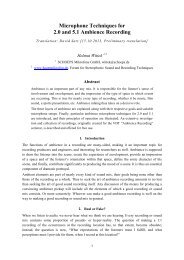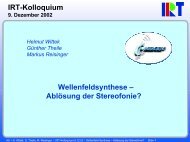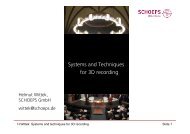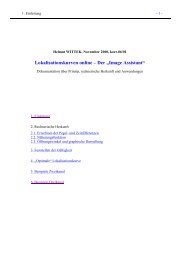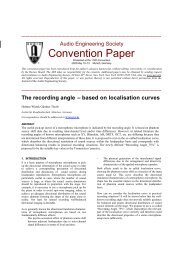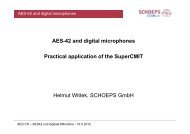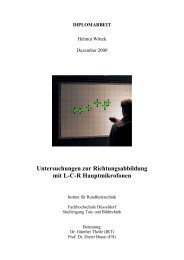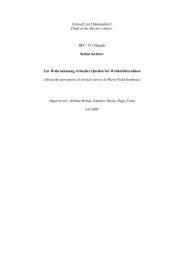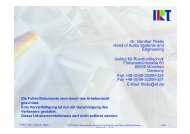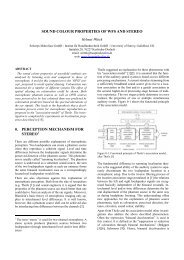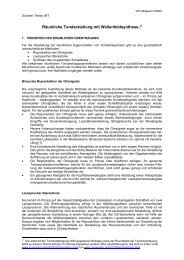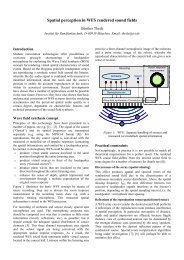on the localisation in the superimposed soundfield - Hauptmikrofon ...
on the localisation in the superimposed soundfield - Hauptmikrofon ...
on the localisation in the superimposed soundfield - Hauptmikrofon ...
Create successful ePaper yourself
Turn your PDF publications into a flip-book with our unique Google optimized e-Paper software.
6<br />
occurrence of laterally displaced auditory events. Never<strong>the</strong>less, <strong>the</strong>re is no<br />
verified hypo<strong>the</strong>sis that allows for a generalisati<strong>on</strong> of <strong>the</strong>se f<strong>in</strong>d<strong>in</strong>gs with respect<br />
to spatial hear<strong>in</strong>g. Hi<strong>the</strong>rto, <strong>the</strong> functi<strong>on</strong>al relati<strong>on</strong>ship between lateralised<br />
and localised auditory event locati<strong>on</strong>s is unknown (see Chapter 5).<br />
4. The “cocktail party effect” implies that a target signal arriv<strong>in</strong>g from a certa<strong>in</strong><br />
directi<strong>on</strong> will be masked less by an <strong>in</strong>terfer<strong>in</strong>g signal arriv<strong>in</strong>g from a different<br />
directi<strong>on</strong> if a subject listens b<strong>in</strong>aurally ra<strong>the</strong>r than m<strong>on</strong>aurally. Generally<br />
speak<strong>in</strong>g, for both <strong>the</strong> <strong>superimposed</strong> sound field as well as headph<strong>on</strong>e-based<br />
sound reproducti<strong>on</strong>, <strong>the</strong> mask<strong>in</strong>g threshold for <strong>the</strong> target signal decreases if <strong>the</strong><br />
target and masker signals produce auditory events at different locati<strong>on</strong>s. It<br />
seems that lateralisati<strong>on</strong> experiments c<strong>on</strong>ducted <strong>in</strong> <strong>the</strong> area of b<strong>in</strong>aural signal<br />
detecti<strong>on</strong> are clearly related to <strong>the</strong> questi<strong>on</strong> of which ear signal comp<strong>on</strong>ents<br />
can be discrim<strong>in</strong>ated by <strong>the</strong> hear<strong>in</strong>g system <strong>in</strong> <strong>the</strong> <strong>superimposed</strong> sound field.<br />
Up to now, however, little is known about <strong>the</strong> significance of so-called “detecti<strong>on</strong><br />
models” to <strong>the</strong> localisati<strong>on</strong> process <strong>in</strong> <strong>the</strong> <strong>superimposed</strong> sound field (see<br />
Secti<strong>on</strong> 4.3.2).<br />
These examples <strong>in</strong>dicate that ra<strong>the</strong>r than <strong>in</strong>vestigat<strong>in</strong>g it “holistically”, <strong>the</strong> spatial<br />
hear<strong>in</strong>g mechanism of <strong>the</strong> auditory system has largely been studied <strong>in</strong> terms of<br />
demarcated sub-areas so far. Perhaps this may be expla<strong>in</strong>ed by <strong>the</strong> efforts of<br />
communicati<strong>on</strong>s eng<strong>in</strong>eers to model immediately any observed relati<strong>on</strong>ships between<br />
properties of sound and auditory events <strong>in</strong> <strong>the</strong> form of psychoacoustic pr<strong>in</strong>ciples,<br />
<strong>the</strong>reby necessitat<strong>in</strong>g a precise demarcati<strong>on</strong>.<br />
The above examples fur<strong>the</strong>r show that especially <strong>the</strong> limits of <strong>the</strong> areas of validity of<br />
<strong>in</strong>dividual auditory phenomena as well as possible <strong>in</strong>terrelati<strong>on</strong>s between <strong>the</strong>se<br />
phenomena must be of particular <strong>in</strong>terest, which can also be said about <strong>the</strong> f<strong>in</strong>d<strong>in</strong>gs<br />
from o<strong>the</strong>r scientific fields such as neurophysiology and perceptual research. In this<br />
respect, <strong>the</strong> use of associative storage technology, signal process<strong>in</strong>g (e.g. see<br />
WIGSTROEM 1974, WILLWACHER 1976, KOHONEN 1977, BOHN 1978) and<br />
possibly also holography (see WESS / ROEDER 1977) may create new possibilities<br />
(see Secti<strong>on</strong> 3.2.1).<br />
In this <strong>the</strong>sis, a model for <strong>the</strong> localisati<strong>on</strong> process <strong>in</strong> <strong>the</strong> <strong>superimposed</strong> sound field will<br />
be described that takes <strong>in</strong>to account a large number of different auditory phenomena<br />
<strong>in</strong> a uniform manner. It is based <strong>on</strong> <strong>the</strong> noti<strong>on</strong> that localisati<strong>on</strong> occurs due to a<br />
“comparis<strong>on</strong> of current and learnt stimulus patterns” (PLENGE 1973). That is, <strong>the</strong><br />
mapp<strong>in</strong>g of auditory events takes place as a result of auditory experience. If <strong>the</strong> ear<br />
signals’ dependency <strong>on</strong>to sound source locati<strong>on</strong> is <strong>in</strong>terpreted as a mechanism for<br />
encod<strong>in</strong>g spatial <strong>in</strong>formati<strong>on</strong>, <strong>the</strong>n knowledge of this dependency can be seen as a key<br />
for decod<strong>in</strong>g <strong>the</strong> spatial <strong>in</strong>formati<strong>on</strong>. In <strong>the</strong> <strong>superimposed</strong> sound field, localisati<strong>on</strong><br />
<strong>the</strong>refore manifests itself as a process for <strong>the</strong> simultaneous decod<strong>in</strong>g of different



